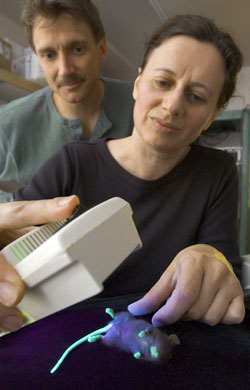Stem Cells Don't Regenerate Heart Muscle
Search on for other ways to use marrow cells in treating heart disease
Once, the promise of bone marrow stem cell therapy had included the possible rebuilding of heart muscle tissue in mice. But two studies published in 2004, including one by researchers at the UW, have shown that the cells do not help regenerate tissue in mice hearts damaged by heart attacks.
 |
| Stem cell researcher Dr. Charles Murry and pathology research associate Dr. Veronica Muskheli examine a transgenic mouse that expresses jellyfish genes by glowing bluish-green when exposed to ultraviolet light. The technique is used to track stem cells used in heart disease research. |
The UW study, and another one conducted at Stanford University showing similar results, were published in the journal Nature on March 21, 2004. Those results contradict a 2001 study conducted elsewhere that suggested the marrow-derived stem cells could convert into heart muscle cells in mice. The 2001 study had prompted human clinical trials for such stem cell therapy in the treatment of a heart attack.
Following the earlier study, other researchers tried to reproduce the results in mice. Dr. Charles Murry, professor of pathology, led a team of researchers at the UW and at the Wells Center for Pediatric Research at Indiana University during a study of stem cell therapy. They injected haematopoietic stem cells (HSCs), which typically form blood cells, into the wall of the heart in both normal mice and in mice with hearts damaged by heart attacks.
Murry and his colleagues found that the stem cells did not convert into heart muscle cells in either group, and the damaged heart muscle tissue did not regenerate. The results represent a break from previous research, including the 2001 study by Dr. Don Orlic of the National Institutes of Health and researchers from New York Medical College. That study indicated such stem cells could help regenerate damaged heart muscle tissue after a myocardial infarction, or heart attack.
Murry and his colleagues spent two years trying to reproduce the results of the earlier study.
"It kept coming up negative. We were thinking we had done something wrong," Murry said.
Because both Murry's study and the one conducted at Stanford show that the stem cells do not convert as expected, these findings call into question the results from the Orlic study published in 2001.
"That group's work is simply not reproducible," said Murry. "Their study prompted a series of premature clinical trials for the treatment of acute heart attacks, which are still going on now."
Even though the stem cells did not regenerate heart muscle tissue, there are other potential benefits of stem cell therapy for damaged hearts.
"It turns out there are many ways you can repair the heart," Murry explained. "It's possible that bone marrow stem cells could have benefits that were unsuspected at the time the human clinical trials were designed."
Stem cells could boost blood flow in the blood vessel beds surrounding the damaged area of the heart, Murry said, which would help salvage the damaged tissue. Stem cell therapy could also potentially be used after a heart attack to prevent remodeling in the heart, which is when the heart dilates following an infarction. That dilation can further damage the heart muscle, so preventing the dilation could help avoid the damage.
"Now that the trials are under way and appear safe, it is probably worthwhile continuing to see whether they are effective," Murry added.
Though Murry's research has shown that bone marrow stem cells can't regenerate muscle tissue, there is evidence that they can regenerate blood vessel cells. His group has applied for a federal grant to fund a clinical trial testing that theory.
They hope to transplant bone marrow stem cells into the hearts of patients with end-stage heart disease who are having a heart-assisting devices surgically implanted in their chests. When a patient later has a heart transplant, the researchers can study the heart tissue to see if the stem cells helped re-grow blood vessels.
They can also use non-invasive imaging techniques, such as positron emission tomography (PET), to monitor the amount of blood flowing through the heart. An increase in blood flow could indicate a re-growth of blood vessels, Murry explained.
Murry's research would be part of a larger program of translational medicine that includes Dr. Daniel Bowen-Pope, professor of pathology; Dr. Rainer Storb, professor of oncology and researcher at the Fred Hutchinson Cancer Research Center; and Dr. Beverly Torok-Storb, researcher at the FHCRC.
In addition to studying the use of stem cells for tissue growth, researchers in that program will examine the effectiveness of using stem cells to induce the body to tolerate organ transplants. A patient receiving an organ transplant usually needs to have their immune system suppressed, often with medication taken for the rest of their lives, so their body doesn't reject the organ. But that leaves a patient susceptible to infections and other medical conditions.
"When people get organ transplants, one of the things they die from most often is complications from immune system suppression," Murry explained. "If we could figure out a way to transplant organs without having to immuno-suppress patients for the rest of their lives, it would be as if they had their own organs."